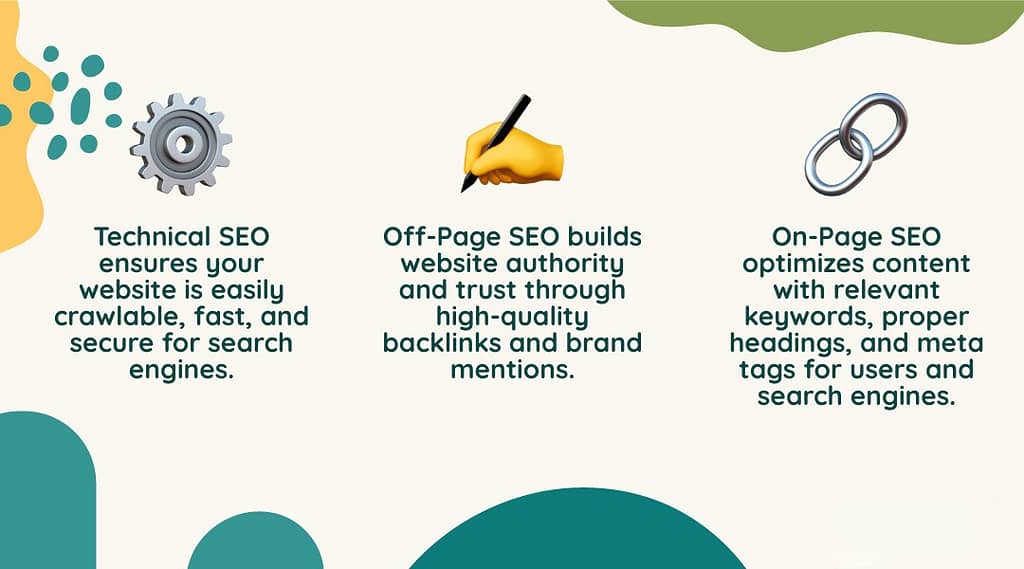What Makes a Website SEO-Friendly?

Here at Altada we build SEO friendly websites so search engines can easily find, understand, and rank its content. This helps your business get found by the right people on Google. It is designed to perform well in search results by combining a strong technical setup, a great user experience, and high-quality content.
An SEO-friendly site has:
- Strong Technical Setup: Fast loading speeds, mobile-friendliness, and secure connections (HTTPS) so search engines can crawl and index pages.
- Great User Experience (UX): Clear navigation and easy-to-read content to keep visitors engaged.
- High-Quality, Relevant Content: Useful information that matches what people are searching for.
An SEO-friendly site helps your target audience find you without paid ads. It balances technical needs, user experience, and valuable content.
At Altada our expertise is in digital marketing focusing on how an SEO friendly website drives growth.

Key Takeaways
- An SEO friendly website combines technical soundness, a great user experience, and high-quality content.
- Mobile-first indexing and page speed are critical ranking factors that Google prioritizes.
- On-page SEO, including optimized titles, URLs, and content, is foundational for search engine understanding.
- Technical SEO, such as creating sitemaps and ensuring indexability, allows search engines to find and rank your pages.
- High-quality, helpful content that matches search intent is the single most important ranking factor.
- A positive user experience (UX) directly contributes to better engagement metrics and higher rankings.
- Monitoring performance with tools like Google Search Console is essential for continuous improvement.
The Foundation: Technical SEO and Site Structure

Think of technical SEO as the hidden engine of your website; it ensures search engines can easily find, understand, and rank your content.
Technical SEO is the foundation of an SEO friendly website. It’s the behind-the-scenes work that allows search engines to crawl, index, and understand your site. Without it, your content may not be seen. Common SEO problems include broken links, slow pages, or content search engines can’t see. Fixing these is key to an SEO-friendly website. Our Web Design services build these principles in from the start.
Key Technical Elements of an SEO-Friendly Website
To be visible online, search engines must easily find and understand your website’s pages.
For your site to appear in search results, Google must find and understand its content. This requires a few technical elements.
XML Sitemaps act as a map for search engines, listing all the pages you want Google to find. This is useful for large sites and helps Google find your content faster. You can learn more about site maps here.
Robots.txt tells search engine robots which parts of your site to avoid, such as private admin pages or shopping carts.
Noindex tags tell search engines not to index specific pages, like a “thank you” page after a purchase.
Canonical URLs specify the main version of a page when you have similar content on different URLs. This prevents duplicate content issues and consolidates ranking power.
Crawlability and Indexability mean ensuring Google can see and access all parts of your page, including images and scripts. If Google can’t see everything, it can’t fully understand your content. Use the URL Inspection Tool in Search Console to check how Google views your page.
Optimizing for Speed and Mobile-Friendliness
Your website needs to load fast and work perfectly on mobile devices for both happy users and better search rankings.
Most people browse on their phones, so a fast, mobile-friendly website is essential for high rankings.
Google uses Mobile-First Indexing, meaning it primarily uses the mobile version of your site for ranking. Your site must work perfectly on mobile devices. See Google’s mobile-first documentation for details.
A Responsive Design ensures your site works well on all devices, which is key for user experience and SEO.
Page Speed is a ranking factor and part of Google’s Core Web Vitals, which measure user experience. A faster site leads to better rankings. Check your speed with tools like page speed.
Image Optimization means reducing image file sizes without losing quality to improve load times. Aim for images under 250KB and use descriptive file names and alt text.
HTTPS Security is mandatory. It signals to Google that your site is trustworthy. An SSL certificate is easy to get and often free from your web host.
Building a Logical Website Structure
A well-organized website helps both your visitors and search engines easily find and understand your content.
Your website’s content arrangement significantly impacts SEO.
Good Site Architecture makes it easy for search engines to crawl your site. A “flat” structure, where important pages are a few clicks from the homepage, is ideal for users and search engines.
Clear Navigation, including easy-to-use menus and breadcrumbs, helps users and creates internal links for SEO.
Internal Linking connects pages on your site. It helps Google find new pages, distribute authority, and understand content context. Strategically add internal links with descriptive anchor text.
URL Slugs should be clean, descriptive, and easy to understand for both users and search engines. Google considers words in the URL, so keep your URL slugs tidy.
Content Silos involve grouping related content. For example, a construction site could have a “concrete services” silo with pages on driveways and patios. This signals topical expertise to Google and can improve rankings.
User Experience (UX) is critical. An easy-to-use, fast, and secure site keeps visitors engaged, signaling high quality to search engines.
On-Page SEO: Crafting Content for Users and Search Engines

On-page SEO transforms your individual web pages into magnets for both search engines and your ideal customers.
With a solid technical foundation, focus on on-page SEO. This involves optimizing individual pages to attract and engage your audience. Google states that content quality is the strongest ranking factor. Create helpful, people-first content that serves user needs, not just algorithms. Good on-page optimization connects what your audience searches for with what you offer. Our Content Optimization services focus on this human-centered approach.
The Role of Keyword Research and Search Intent
Understanding what your audience actually searches for is the foundation of content that connects and converts.
Before writing, understand your audience and what terms they use on Google. This goes beyond keywords to understanding the story behind each search. Search intent is the “why” behind a query. For example, “how to build an SEO friendly website” has educational inte nt, while “hire SEO agency” has commercial intent. Match your content to the user’s intent to improve rankings.
Long-tail keywords like “SEO friendly website checklist for small business” are specific and less competitive than broad terms like “SEO.” They reveal specific user problems you can solve with targeted content. Keyword research reveals customer questions and problems, shaping your content strategy. While tools show which keywords to target, understanding audience needs is key to using them naturally.
Best Practices for an SEO-Friendly Website’s On-Page Elements
Every visible element on your page is an opportunity to communicate value to both search engines and potential customers.
Your title tag is your page’s first impression in search results. A good title includes the main keyword, is under 60 characters, and clearly states the page’s offer. Effective page titles improve click-through rates.
Meta descriptions appear under the title in search results and should convince users to click. Write compelling SEO titles and descriptions that match user intent.
Your heading structure helps users scan content and helps Google understand its hierarchy. Use one H1 tag for the main topic and H2s, H3s for subtopics. Use relevant keywords in headings but prioritize readability.
For keyword placement, put your target keyword in the first 100-150 words and use related terms naturally. Google understands context, so avoid keyword stuffing, which harms user experience and rankings.
Optimizing Media and Advanced On-Page Tactics
Rich media and structured data help your content stand out in search results while providing a better user experience.
Images need descriptive alt text for search engines and visually impaired users. Use relevant file names, compress images for speed, and place them near related text for context. Proper alt text is key for accessibility and SEO.
Video content should have descriptive titles and descriptions. Provide transcripts to give search engines more text to index and improve accessibility.
Schema markup is structured data that helps Google understand your content, leading to rich snippets like ratings or FAQs in search results. These improved listings can increase clicks. See the Schema.org documentation for guidance.
Structured data is also crucial for new features like Google’s AI Overviews. Learn How to Rank in AI Overviews to gain an edge. Successful on-page SEO balances user needs with search engine visibility. When done right, your SEO friendly website will attract and convert customers.
Off-Page SEO: Building Authority and Trust

Off-page SEO helps your website become a trusted authority online, building its reputation through external signals.
Off-page SEO builds your website’s credibility and trust through external signals that happen outside your site. When reputable sites link to you, it signals trust to Google. This trust is part of E-E-A-T: Expertise, Experience, Authoritativeness, and Trustworthiness. An SEO friendly website earns this trust over time.
Earning High-Quality Backlinks
Backlinks from trustworthy sources are like powerful endorsements, telling Google your site is a valuable resource.
Backlinks are links from other websites to yours and are a major ranking factor. Quality is more important than quantity. Earn links by creating useful, unique content. One method is writing guest posts for relevant industry websites and including a link back to your site.
Broken link building involves finding broken links on other sites and suggesting your content as a replacement. Other strategies include creating link-worthy content (like original research or guides) and using Digital PR to get media mentions. As Nielsen research on trust shows, these earned recommendations build trust.
Expanding Your Reach with Local and Brand SEO
Optimizing for local search and building a strong brand online helps your website reach more of the right people.
For businesses with a physical location, local SEO is crucial for attracting nearby customers.
Local SEO focuses on a specific geographic area. A key part is optimizing your Google Business Profile with accurate information, good photos, and customer reviews.
Online reviews build trust and can affect local search rankings. Brand mentions, even without links, signal authority. Social media signals are not a direct ranking factor, but social activity drives traffic and brand awareness, indirectly helping SEO.
How to Monitor and Improve Your SEO-Friendly Website
Consistent monitoring and adaptation are essential for maintaining and improving your website’s SEO performance over time.
An SEO friendly website requires ongoing care. Search engine algorithms change, user behavior shifts, and competitors adapt. Monitoring performance is essential to stay ahead. Regular monitoring helps you find issues early and identify growth opportunities. Start by signing up for Google Search Console, a free tool with key insights. Understanding changes like How Google Core Updates Affect Search Rankings helps you adapt your strategy proactively.
Essential Tools for SEO Monitoring
Leveraging the right tools provides valuable insights into your website’s search performance and areas for improvement.
You don’t need expensive tools to monitor your site. Google’s free tools offer powerful insights.
Google Search Console is a free tool showing your site’s performance in Google search. It identifies keywords, technical errors, and user experience opportunities. Given Google’s market share, this data is critical. You can get GSC here.
Google Analytics shows what users do on your site, tracking traffic, behavior, and conversions. Together, these tools provide a full picture of your SEO performance.
Bing Webmaster Tools offers similar insights for Bing, the second-largest search engine. Setup is quick.
Key metrics to track include organic traffic, keyword rankings, click-through rate, and bounce rate. These metrics show if your SEO efforts are effective.
Adapting to Search Engine Algorithm Changes
Search engine algorithms are constantly evolving, requiring continuous adaptation of your SEO strategies.
Google releases thousands of algorithm updates annually. While most are minor, some can significantly affect rankings. Staying informed and adapting is key.
The Helpful Content Update rewards content created for people, not just search engines. It emphasizes helping your audience.
Core updates are broad changes to Google’s ranking systems. When rankings change, focus on creating helpful, accurate, and engaging content.
E-E-A-T (Experience, Expertise, Authoritativeness, Trustworthiness) is Google’s framework for assessing content quality. Demonstrate these qualities by showing credentials, citing sources, and creating helpful content for long-term SEO success.
Stay informed by following Google’s Search Central blog, joining SEO communities, and conducting regular SEO audits. After an update, analyze your data and make thoughtful adjustments based on Google’s quality guidelines. The best defense against algorithm updates is building a genuinely helpful SEO friendly website that serves your audience first.
Frequently Asked Questions about SEO-Friendly Websites
What are the three most important components of an SEO-friendly website?
The three most important components are Technical SEO, On-Page SEO, and Off-Page SEO. Technical SEO is the foundation, ensuring your site is fast, secure (HTTPS), mobile-friendly, and crawlable by search engines. On-Page SEO focuses on your content. It involves creating high-quality, relevant information with optimized titles, headings, and keywords to help both users and search engines. Off-Page SEO builds your site’s authority and trust through external signals like backlinks from reputable sites and brand mentions. A successful SEO friendly website balances all three to serve both search engines and human visitors.
How long does it take to see SEO results?
Seeing significant SEO results, such as higher rankings and more organic traffic, typically takes 6 to 12 months. Minor improvements may appear sooner. The timeline depends on factors like industry competition, your website’s age and authority, and the consistency of your SEO efforts. SEO is a long-term strategy, not a quick fix, but it can deliver a strong return on investment over time.
Can I do SEO myself?
Yes, you can do SEO yourself. It requires a commitment to learning the basics of technical, on-page, and off-page SEO. Start with free tools like Google Search Console and conduct keyword research to understand your audience. Focus on creating helpful content that answers their questions. However, DIY SEO has a steep learning curve and requires significant time to keep up with algorithm changes. If you need faster growth or face complex issues, hiring a professional can help create a more effective strategy.
Your Next Steps in Building Online Success
Making your website SEO friendly is an ongoing commitment to quality and user satisfaction. You’ve learned about building a technical foundation, creating valuable content, and building site authority. These steps create sustainable online growth, attracting visitors and turning them into loyal customers.
Leave a Reply